NCERT Solutions | Class 8 Maths Chapter 11 | Mensuration

CBSE Solutions | Maths Class 8
Check the below NCERT Solutions for Class 8 Maths Chapter 11 Mensuration Pdf free download. NCERT Solutions Class 8 Maths were prepared based on the latest exam pattern. We have Provided Mensuration Class 8 Maths NCERT Solutions to help students understand the concept very well.
NCERT | Class 8 Maths
| Book: | National Council of Educational Research and Training (NCERT) |
|---|---|
| Board: | Central Board of Secondary Education (CBSE) |
| Class: | 8th |
| Subject: | Maths |
| Chapter: | 11 |
| Chapters Name: | Mensuration |
| Medium: | English |
Mensuration | Class 8 Maths | NCERT Books Solutions
You can refer to MCQ Questions for Class 8 Maths Chapter 11 Mensuration to revise the concepts in the syllabus effectively and improve your chances of securing high marks in your board exams.
NCERT Solutions for Class 8 Maths Chapter 11 Mensuration Exercise 11.1
Ex 11.1 Class 8 Maths Question 1.
A square and a rectangular field with measurements as given in the following figure have the same perimeter. Which field has a larger area?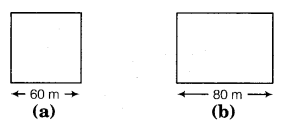
Solution:
Let x be the breadth of the rectangle. It is given that the perimeter of a rectangle = perimeter of the square.∴ 2 (80 + x) = 4 x 60
⇒ 80 + x = 120
⇒ x = 120 – 80 =40
i.e., breadth of the rectangle = 40 m
Now area of the square = (60 x 60) m = 3600 m2
and the area of the rectangle = (40 x 80) m2 = 3200 m2
Hence, the square field has a larger area.
Ex 11.1 Class 8 Maths Question 2.
Mrs. Kaushik has a square plot with the measurement as shown in the figure. She wants to construct a house in the middle of the plot. A garden is developed around the house. Find the total cost of developing a garden around the house at the rate of ₹ 55 per m2.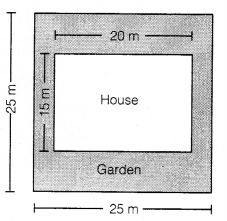
Solution:
Area of the garden = Area of the outer square – Area of the inner rectangle= 25 x 25 m2 – 20 x 15 m2
= (625 – 300) m2 = 325 m2
Cost of developing a garden at the rate of ₹ 55 per sq. metre
= ₹ (55 x 325) = ₹ 17,875
Ex 11.1 Class 8 Maths Question 3.
The shape of a garden is rectangular in the middle and semi circular at the ends as shown in the diagram. Find the area and the perimeter of this garden [Length of rectangle is 20 – (3.5 + 3.5) metres].
Solution:
Total area of the garden = Area of the rectangular portion + The sum of the areas of the pair of semi-circles
Ex 11.1 Class 8 Maths Question 4.
A flooring tile has the shape of a parallelogram whose base is 24 cm and the corresponding height is 10 cm. How many such tiles are required to cover a floor of area 1080 m2?Solution:
Area of one tile = base x height= (24 x 10) cm2 = 240 cm2

Ex 11.1 Class 8 Maths Question 5.
An ant is moving around a few food pieces of different shapes scattered on the floor. For which food piece would the ant have to take a longer round? Remember, circumference of a circle can be obtained by using the expression c = 2πr, where r is the radius of the circle.
Solution:
A, B, C and D in the given figures as shown. Let A be the point in each figure from where the ant start moving on the food pieces. She is to reach the initial point after moving around the boundary of each food piece.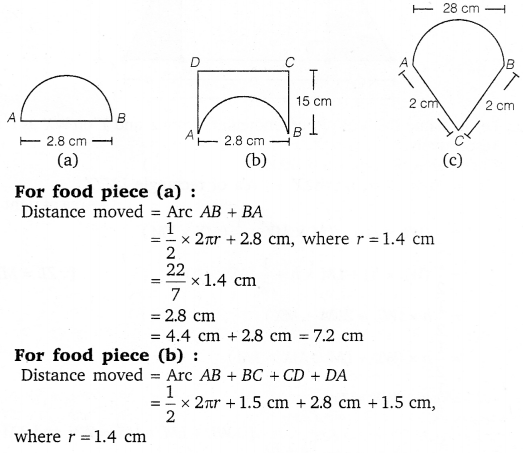
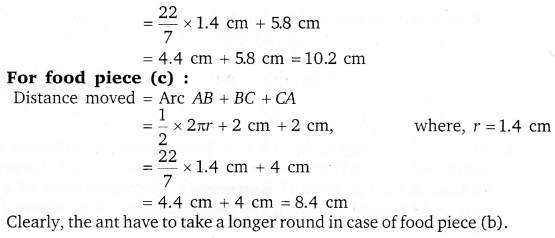
NCERT Solutions for Class 8 Maths Chapter 11 Mensuration Exercise 11.2
Ex 11.2 Class 8 Maths Question 1.
The shape of the top surface of a table is trapezium. Find its area if its parallel sides are 1 m and 1.2 m and perpendicular distance between them is 0.8 m.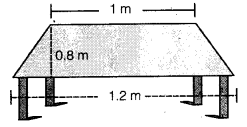
Solution:
Area of top surface of a table= Area of the trapezium


Ex 11.2 Class 8 Maths Question 2.
The area of a trapezium is 34 cm2 and the length of one of the parallel sides is 10 cm and its height is 4 cm. Find the length of the other parallel side.Solution:
Let the required side be x cm.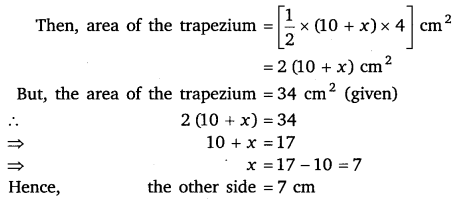
Ex 11.2 Class 8 Maths Question 3.
Length of the fence of a trapezium A shaped field ABCD is 120 m. IF BC = 48 m, CD = 17 m and AD = 40 m, find the area of this field. Side AB is perpendicular to the parallel sides AD B and BC.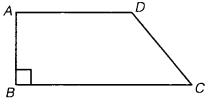
Solution:
Let ABCD be the given trapezium in which BC = 48 m, CD = 17 m andAD = 40 m.
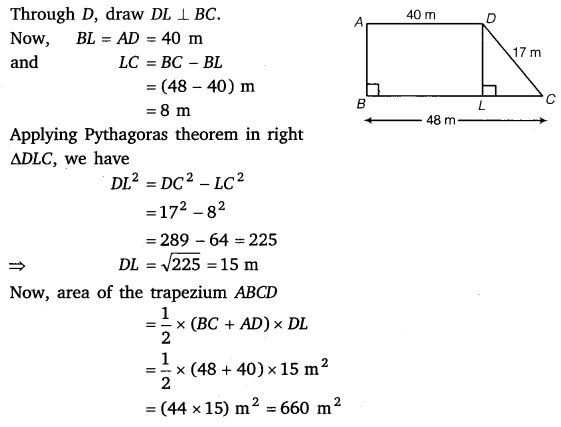
Ex 11.2 Class 8 Maths Question 4.
The diagonal of a quadrilateral shaped field is 24 m and the perpendiculars dropped on it from the remaining opposite vertices are 8 m and 13 m. Find the area of the field.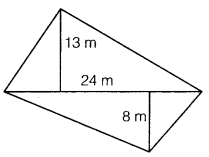
Solution:
Let ABCD be the given quadrilateral in which BE ⊥ AC and DF ⊥ AC.It is given that
AC =24m, BE = 8m and DF = 13 m.
Now, area of quad. ABCD
= area of ∆ABC + area of ∆ACD

Ex 11.2 Class 8 Maths Question 5.
The diagonals of a rhombus are 7.5 cm and 12 cm. Find its area.Solution:
Area of a rhombus = \(\frac { 1 }{ 2 } \) x (product of diagonals)\(=\left( \frac { 1 }{ 2 } \times 7.5\times 12 \right) { cm }^{ 2 }=45{ cm }^{ 2 }\)
Ex 11.2 Class 8 Maths Question 6.
Find the area of a rhombus whose side is 6 cm and whose altitude is 4 cm. If one of its diagonals is 8 cm long, find the length of the other diagonal.Solution:
Let ABCD be a rhombus of side 6 cm and whose altitude DF = 4 cm. Also, one of its diagonals, BD =8 cm.Area of the rhombus ABCD
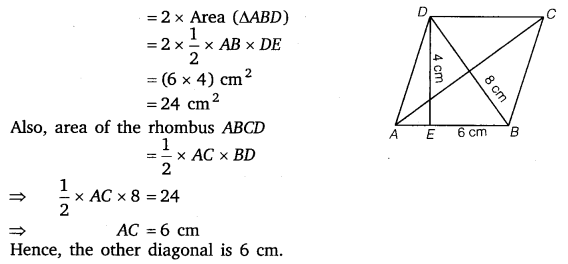
Ex 11.2 Class 8 Maths Question 7.
The floor of a building consists of 3000 tiles which are rhombus shaped and each of its diagonals are 45 cm and 30 cm in length. Find the total cost of polishing the floor, if the cost per m2 is ₹ 4.Solution:
Area of the floor = 3000 x Area of one tile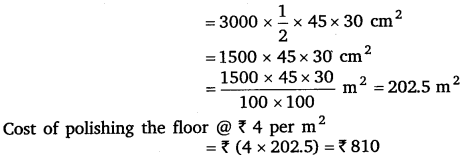
Ex 11.2 Class 8 Maths Question 8.
Mohan wants to buy a trapezium shaped field. Its side along the. river is parallel to and twice the side along the road. If the area of this field is 10500 m2 and the perpendicular distance between the two parallel sides is 100m, find the length of the side along the river.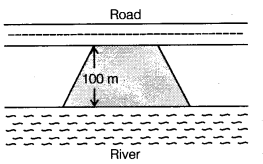
Solution:
Let the parallel sides of the trapezium shaped field berm and 2x m. Then, its area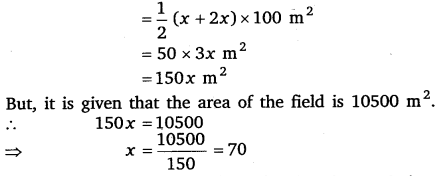
∴ The length of the side along the river is 2 x 70, i.e., 140 metres.
Ex 11.2 Class 8 Maths Question 9.
Top surface of a raised platform is in the shape of a regular octagon as shown in the figure. Find the area of the octagonal surface.Solution:
Area of the octagonal surface ABCDEFGH = Area (trap. ABCH) + Area (rect. HCDG) +Area (trap. GDEF)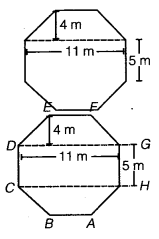
Ex 11.2 Class 8 Maths Question 10.
There is a pentagonal shaped park as shown in the figure. For finding its area Jyoti and Kavita divided it in two different ways.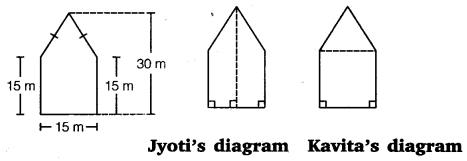
Find the area of this park using both ways. Can you suggest some other way of finding its area?
Solution:
Taking Jyoti’s diagram :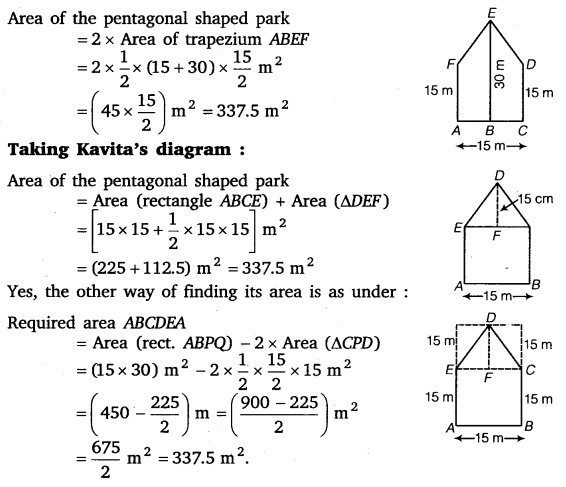
Ex 11.2 Class 8 Maths Question 11.
Diagram of the adjacent picture frame has outer dimensions = 24 cm x 28 cm and inner dimensions 16 cm x 20 cm. Find the area of each section of the frame, if the width of each section is same.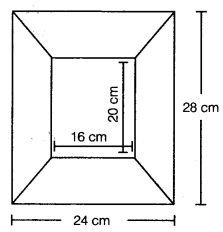
Solution:
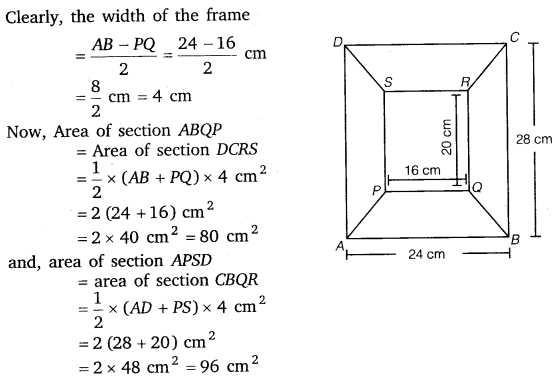
NCERT Solutions for Class 8 Maths Chapter 11 Mensuration Exercise 11.3
Ex 11.3 Class 8 Maths Question 1.
There are two cuboidal boxes as shown in the adjoining figure. Which box requires the lesser amount of material to make?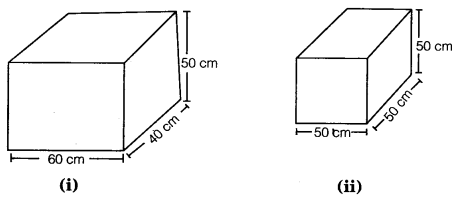
Solution:
Total surface area of first box= 2(lb + bh + lh)
= 2 (60 x 40 + 40 x 50 + 60 x 50) cm2
= 200 (24+20+30) cm2
= 200 x 74 cm2
=14800 cm2
Total surface area of second box
= 6 (Edge)2 = 6 x 50 x 50 cm2
= 15000 cm2
Since the total surface area of first box is less than that of the second, therefore the first box i.e., (a) requires the least amount of material to make.
Ex 11.3 Class 8 Maths Question 2.
A suitcase of measures 80 cm x 48 cm x 24 cm is to be covered with a tarpaulin cloth. How many metres of tarpaulin of width 96 cm is required to cover 100 such suitcases?Solution:
Total surface area of the suitcase= 2 (80 x 48 + 48 x 24 + 80 x 24) cm2
= 2(3840 + 1152 + 1920) cm2
= 2 x 6912 cm2 =13824 cm2
Area of 1 metre of trapaulin = (100 x 96) cm2
= 9600 cm2
Surface area of 100 suitcases =100 x 13824 cm2
Trapaulin required to cover 100 suitcases
\(\frac { 100\times 13824 }{ 9600 } meters\)
= 144 metres
Ex 11.3 Class 8 Maths Question 3.
Find the side of a cube whose surface area is 600 cm2.Solution:
Let a be the side of the cube having surface area 600 cm2.∴ 6a2 =600 ⇒ a2 =100 ⇒ a =10
Hence, the side of the cube = 10 cm.
Ex 11.3 Class 8 Maths Question 4.
Rukhsar painted the outside of the cabinet of measure 1 m x 2 m x 1.5 m. How much surface area did she cover if she painted all except the bottom of the cabinet.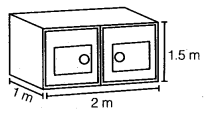
Solution:
Here l = 2 m, b = 1 m and h = 1.5 mArea to be painted = 2bh + 2lh + lb
= (2 x 1 x 1.5 + 2 x 2 x 1.5 + 2 x 1) m2
= (3 + 6+2) m2 =11 m2
Ex 11.3 Class 8 Maths Question 5.
Daniel is painting the walls and ceiling of a cuboidal hall with length, breadth and height of 15 m, 10 m and 7 m respectively. From each can of paint 100 m2 of area is painted.How many cans of paint will she need to paint the room?
Solution:
Here l = 15 m, b = 10 m and h = 7 mArea to be painted = 2bh + 2lh + lb
= (2 x 10 x 7 + 2 x 15 x 7 + 15 x 10) m2
= (140 + 210 + 150) m2 =500 m2
Since each can of paint covers 100 m2, therefore number of cans required \(=\frac { 500 }{ 100 } =5\).
Ex 11.3 Class 8 Maths Question 6.
Describe how the two figures at the right are alike and how they are different. Which box has larger lateral surface area?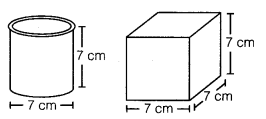
Solution:
The given figure are alike in their heights. They differ as under :(i) One is named cylinder and the other is a cube.
(ii) Cylinder is a solid obtained by revolving a rectangular lamina about one of its sides whereas cube is solid bounded by six squares.
(iii) Cylinder has two circular faces, whereas cube has six faces.
Given,
r = \(\frac { 7 }{ 2 } \) cm, h = 7 cm =\(\left( 2\times \frac { 22 }{ 7 } \times \frac { 7 }{ 22 } \times 7 \right) \) cm2 = 154 cm2
Lateral surface area of cylinder = 2πrh and, lateral surface area of cube
= Perimeter of base x height = (4 x 7 x 7) cm2 = 196 cm2
Clearly, cube has larger lateral surface area.
Ex 11.3 Class 8 Maths Question 7.
A closed cylindrical tank of radius 7 m and height 3 m is made from a sheet of metal. How much sheet of metal is required?Solution:
Here, r = 7 m and h = 3 m.Sheet of metal required to make a closed cylinder
= Total surface area of the cylinder
= (2πrh + 2πr2) sq. units
\(=\left( 2\times \frac { 22 }{ 7 } \times 7\times 3+2\times \frac { 22 }{ 7 } \times 7\times 7 \right) \) 2
=(138 + 308)m2 = 440 m2
Ex 11.3 Class 8 Maths Question 8.
The lateral surface area of a hollow cylinder is 4224 cm2. It is cut along its height and formed a rectangular sheet of width 33 cm. Find the perimeter of rectangular sheet.Solution:
When a hollow cylinder is cut along its height and formed into a rectangular sheet. Then, the circumference of the base of cylinder is equal to the length of the sheet and the height of the cylinder is equal to the breadth of the sheet. Therefore, lateral surface area of the cylinder is equal to the area of the rectangular sheet. Let? be the length of the sheet.∴ Area of the sheet = Lateral surface area of cylinder
⇒ l x 33 = 4224
⇒ \(l=\left( \frac { 4224 }{ 33 } \right) cm=128cm\)
Now, perimeter of rectangular sheet
= 2 (l + b) = 2 (128 + 33) cm
= 2 x 161 cm
= 322 cm
Ex 11.3 Class 8 Maths Question 9.
A road roller takes 750 complete revolutions to move once over to level a road. Find the area of the road if the diameter of a road roller is 84 cm and length is 1 m.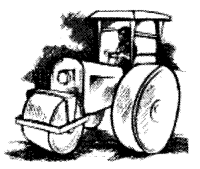
Solution:
Road roller is a cylinder whose radius,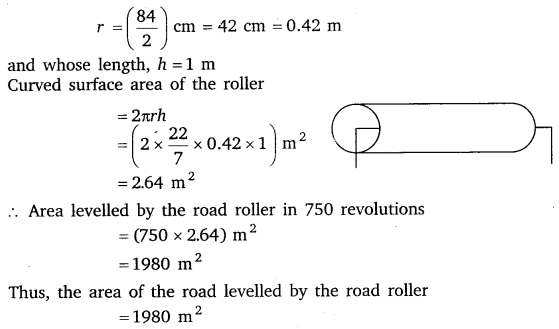
Ex 11.3 Class 8 Maths Question 10.
A company packages its milk powder in cylindrical container whose base has a diameter of 14 cm and height 20 cm. Company places a label around the surface of the container (as shown in the figure). If the label is placed 2 cm from top and bottom, what is the surface area of the label.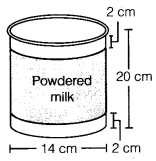
Solution:
Since the company places a label around the surface of the cylindrical container of radius 7 cm and height 20 cm such that it is placed 2 cm from top and bottom.∴ We have to find the curved surface of a cylinder of radius 7 cm and height (20 – 4) cm i.e., 16 cm. ,
This curved surface area = \(\left( 2\times \frac { 22 }{ 7 } \times 7\times 16 \right) { cm }^{ 2 }\)
= 704 cm2
NCERT Solutions for Class 8 Maths Chapter 11 Mensuration Exercise 11.4
Ex 11.4 Class 8 Maths Question 1.
Given a cylindrical tank, in which situation will you find surface area and in which situation volume.(a) To find how much it can hold.
(b) Number of cement bags required to plaster it.
(c) To find the number of smaller tanks that can be filled with water from it.
Solution:
(a) Volume(b) Surface area
(c) Volume
Ex 11.4 Class 8 Maths Question 2.
Diameter of cylinder A is 7 cm, and the height is 14 cm. Diameter of cylinder B is 14 cm and height is 7 cm. Without doing any calculations can you suggest whose volume is greater? Verify it by finding the volume of both the cylinders. Check whether the cylinder with greater volume also has greater surface area?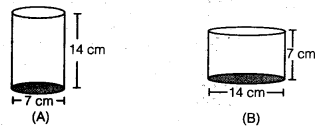
Solution:
Cylinder B has greater volume.Surface area of cylinder A
= (2πrh + 2πr2 sq. units,
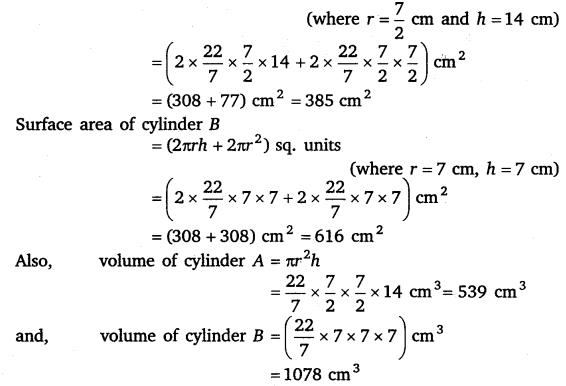
Thus, cylinder having greater volume also has greater surface area.
Ex 11.4 Class 8 Maths Question 3.
Find the height of a cuboid whose base area is 180 cm2 and volume is 900 cm3?Solution:
Volume of the cuboid =900 cm3⇒ (Area of the base) x Height = 900 cm3
⇒ 180 x Height = 900
⇒ Height = \(\frac { 900 }{ 180 } \) = 5
Hence, the height of the cuboid is 5 cm.
Ex 11.4 Class 8 Maths Question 4.
A cuboid is of dimensions 60 cm x 54 cm x 30 cm. How many small cubes with side 6 cm can be placed in the given cuboid?Solution:

Ex 11.4 Class 8 Maths Question 5.
Find the height of the cylinder whose volume is 1.54 m3 and diameter of the base is 140 cm?Solution:
Let the h be the height of cylinder whose radius, r = \(\frac { 140 }{ 2 } \) cm = 70 cm = \(\frac { 70 }{ 100 } \) m and volume =1.54 m3.
Ex 11.4 Class 8 Maths Question 6.
A milk tank is in the form of cylinder whose radius is 1.5 m and length is 7 m. Find the quantity of milk in liters that can be stored in the tank?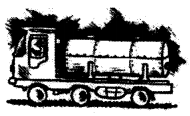
Solution:
Quantity of milk that can be stored in the tank = Volume of the tank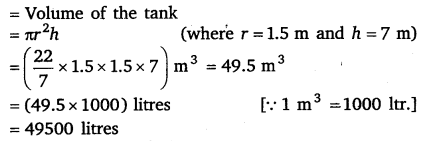
Ex 11.4 Class 8 Maths Question 7.
If each edge of a cube is doubled,(i) how many times will its surface area increase?
(ii) how many times will its volume increase?
Solution:
Let x units be the edge of the cube. Then, its surface area = 6x2 and its volume = x3.When its edge is doubled,
(i) Its surface area = 6 (2x)2 = 6 x 4 x 2 = 24 x 2
⇒ The surface area of the new cube will be 4 times that of the original cube.
(ii) Its volume = (2x)3 = 8x3.
⇒ The volume of the new cube will be 8 times that of the original cube.
Ex 11.4 Class 8 Maths Question 8.
Water is pouring into a cuboidal reservoir at the rate of 60 liters per minute. If the volume of reservoir is 108 m3, find the number of hours it will take to fill the reservoir.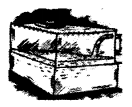
Solution:
Volume of the reservoir =108 m3= 108 x 1000 litres
= 108000 litres
Since water is pouring into reservoir @ 60 litres per minute
∴ Time taken to fill the reservoir = \(\frac { 108000 }{ 60\times 60 } \) hours
= 30 hours
NCERT Class 8 Maths
Class 8 Maths Chapters | Maths Class 8 Chapter 11
NCERT Solutions for Class 8 Maths
NCERT Solutions of Maths Class 8 Chapter-wise
Chapter-wise NCERT Solutions for Class 8 Maths
-
NCERT Solutions For Class 8 Maths Chapter 1 Rational Numbers
NCERT Solutions For Class 8 Maths Chapter 2 Linear Equations in One Variable
NCERT Solutions For Class 8 Maths Chapter 3 Understanding Quadrilaterals
NCERT Solutions For Class 8 Maths Chapter 4 Practical Geometry
NCERT Solutions For Class 8 Maths Chapter 5 Data Handling
NCERT Solutions For Class 8 Maths Chapter 6 Squares and Square Roots
NCERT Solutions For Class 8 Maths Chapter 7 Cubes and Cube Roots
NCERT Solutions For Class 8 Maths Chapter 8 Comparing Quantities
NCERT Solutions For Class 8 Maths Chapter 9 Algebraic Expressions and Identities
NCERT Solutions For Class 8 Maths Chapter 10 Visualising Solid Shapes
NCERT Solutions For Class 8 Maths Chapter 11 Mensuration
NCERT Solutions For Class 8 Maths Chapter 12 Exponents and Powers
NCERT Solutions For Class 8 Maths Chapter 13 Direct and Indirect proportions
NCERT Solutions For Class 8 Maths Chapter 14 Factorisation
NCERT Solutions For Class 8 Maths Chapter 15 Introduction to Graphs
NCERT Solutions For Class 8 Maths Chapter 16 Playing with Numbers
NCERT Solutions for Class 6 to 12
-
NCERT Solutions for Class 6 All Subjects
NCERT Solutions for Class 7 All Subjects
NCERT Solutions for Class 8 All Subjects
NCERT Solutions for Class 9 All Subjects
NCERT Solutions for Class 10 All Subjects
NCERT Solutions for Class 11 All Subjects
NCERT Solutions for Class 12 All Subjects

Post a Comment
इस पेज / वेबसाइट की त्रुटियों / गलतियों को यहाँ दर्ज कीजिये
(Errors/mistakes on this page/website enter here)